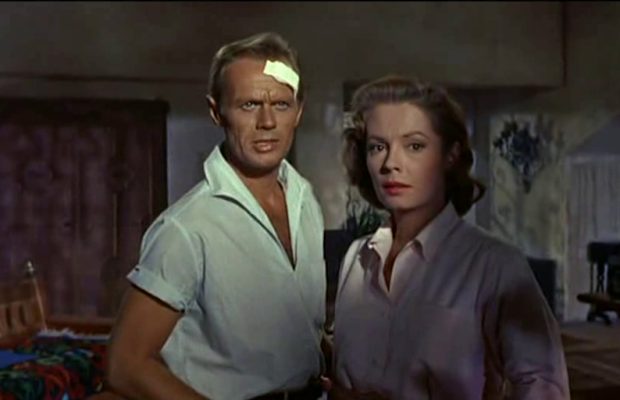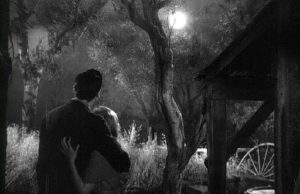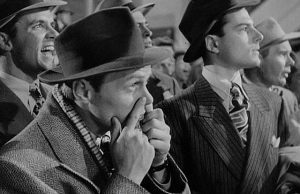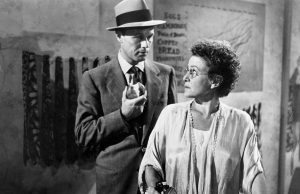Run for the Sun (1956)

Toronto Film Society presented Run for the Sun (1956) on Monday, October 24, 2016 in a double bill with Johnny Allegro as part of the Season 69 Monday Evening Film Buff Series, Programme 2.
Production: Russ-Field Corporation. Producer: Harry Tatelman. Director: Roy Boulting. Screenplay: Roy Boulting and Dudley Nichols, based on the story “The Most Dangerous Game” by Richard Connell. Music: Fred Steiner. Cinematography: Joseph LaShelle. Film Editor: Frederic Knudtson. Art Direction: Alfred Ybarra. Costumes by: James H. Garlock.
Cast: Richard Widmark (Michael ‘Mike’ Latimer), Trevor Howard (Browne), Jane Greer (Katherine ‘Katie’ Connors), Peter van Eyck (Dr. Van Anders/Col. Wilham Von Andre), Juan Garcia (Fernandez), José Antonio Carbajal (Paco), José Chávez (Pedro), Guillermo Calles (Paco), Margarito Luna (Gran-Hotel Proprietor), Guillermo Bravo Sosa (Gran-Hotel Waiter), Enedina Diaz de León (Paco’s Wife), Carlos Hennings (Jan, Pilot).
Excluding his cameo in Around the World in Eighty Days, Trevor Howard headed off to Mexico to make his second major Hollywood film, Run for the Sun. Although produced by an American, Harry Tatelman, it was directed by the British Roy Boulting, one of the famous Boulting brothers whose earlier film, Seven Days to Noon we screened at TFS’s first Sunday programme of this season. This was Roy’s first American film and also a film that he worked on independently from his twin, John. This time Roy worked closely with Dudley Nichols, one of John Ford’s favourite screenwriters, on the screenplay.
Based on the 1932 film The Most Dangerous Game, Trevor had the role of the sadistic Lord, and for once proved thoroughly unlikeable in a chillingly convincing performance. It was also a role that virtually wiped out his chance ever to become a convincing major heroic film star and established him more as a screen character actor. Although there would be the occasional typical ‘leading man’ role, it was being a successful and unintentional scene-stealing character actor that kept him solidly in work for the rest of his life.
In his 1990 book Trevor Howard: The Man and His Films, Michael Munn states that Producer Harry Tatelman had wanted Leo Genn to play the part of Lord Haw-Haw but when Genn read the script he turned it down flat. The name Trevor Howard meant little to the producer, but to Roy Boulting it was a name to be respected, and so he prompted his producer to offer the role to Trevor. It meant taking third billing, but Trevor was excited by the prospect of further exposure to American audiences and, no doubt, of working for the first time in Mexico—and most likely trying out the tequila!
Richard Widmark had top billing while second billing went to Jane Greer who had taken a leave from the screen in 1953 to raise a family. She and Widmark got along well and although there were rumours that they were having an affair, Howard’s wife Helen chose to disbelieve the gossip and after meeting Jane, the two became good friends.
Greer also stood up for Howard when she saw that the producer was not treating him on equal footing with herself and Widmark. Shortly after Trevor was given his own dressing-room, a status indicating that he was important.
We hope you enjoy the “Dangerous Game” theme in a completely different setting!
Introduction by Caren Feldman
The screenplay is based on the short story The Most Dangerous Game, also published as The Hounds of Zaroff, written by Richard Connell and published in Colliers magazine in 1924. A film version was released in 1932 starring Joel McCrea as the hunted and Leslie Banks as the hunter. It was produced by Merian C. Cooper and filmed simultaneously with King Kong and utilized some of the same sets. Fay Wray has a secondary role in The Most Dangerous Game, and the lead in King Kong.
The story and its theme have been made into many films over the years. Some notable versions include: The Naked Prey (1956), directed by and starring Cornell Wilde; Open Season (1974), starring William Holden, Peter Fonda, John Phillip Law, Richard Lynch, and Cornelia Sharp; The Tenth Victim (1965), starring Marcello Mastroianni and Ursula Andress; The Running Man (1987), starring Arnold Schwarzenegger; Savages (1974), a TV movie with Andy Griffith and Sam Bottoms; and The Hunger Games trilogy (2012, 2014, 2015).
In Run for the Sun, Widmark is a Hemingway-like novelist and Greer is a journalist attempting to interview him. The crash of his small plane in the South American jungle leaves them stranded and being hunted by Howard, an Englishman who was a propagandist for the Nazi regime during WWII, and Van Eyck, a Dutch archeologist who is in reality a Nazi officer wanted for war crimes.
With his whitish-blond crew-cut, slow, menacing drawl, and Germanic manner, Van Eyck was destined to be typecast as scowling, arrogant Nazi officers. Peter Van Eyck was the farthest thing from a Nazi. He was born Götz von Eick on July 16, 1911 in Steinwehr, Pomerania. At that time, it was part of the German Empire and is now in Poland. He was an avowed anti-fascist and left Germany before the Nazis came to power. The son of an aristocratic Prussian land owner, his father had intended him to embark on a military career. Instead, Peter spent his education in Berlin, where he trained as a musician. In 1931, he left Germany, living in Paris, London, Tunis, Algiers, and Cuba before settling in New York in 1937. He became acquainted with the composer Aaron Copland and they collaborated on a number of projects. He also worked as composer and lyricist on a variety of songs for revue and cabaret, as well as performing as a pianist in bars and nightclubs. Around this time, he began to work as a stage manager and arranger for Irving Berlin and was an assistant director for Orson Welles’ Mercury Theatre.
Van Eyck moved to Hollywood in the 1940s and became a protégé of Billy Wilder, who got him jobs in radio and small parts in films. His roles were mostly uncredited and he played Nazis. He appeared in the films Hitler’s Children (1943); Hitler’s Madmen (1943); and Edge of Darkness (1943), among others. In 1943, he took U.S. citizenship and was drafted into the army as a commissioned officer. He appeared in the training film Resisting Enemy Interrogation (1944), playing a Nazi officer. At the end of the war, he returned to Germany as a control officer for film, and remained there until 1948 as director of the film section. In 1949, he appeared in his first German film, Hallo, Fräulein! then Royal Children (1950). In both films, he played Americans.
Van Eyck appeared in supporting roles in 1950 and 1952. He gained international attention in the 1953 drama The Wages of Fear. He had other good roles after that: Rosemary (1958); Doctor Crippen Lives (1958); a starring role in The Snorkel (1958); and The Rest is Silence (1959).
In the 1960s, he moved to Switzerland and maintained a residence in Paris. He had numerous roles in French, English, and German films. His more notable later films are: The Longest Day and The Spy Who Came in from the Cold. He appeared in three films about the master criminal Doctor Mabuse that were very popular in Germany. His last role was that of General Von Brock in Bridge at Remagen (1969). The film also starred George Segal, Robert Vaughan, and Ben Gazzara.
Van Eyck was married to the American actress Ruth Ford for a few years during the 1940s. His second wife was Inge von Voris, with whom he had two daughters. His daughter Kristina Von Eyck is an actress currently working in German films. He died in Zurich of sepsis in 1969, just shy of his 58th birthday.
Notes by Bruce Whittaker












Leave a Reply